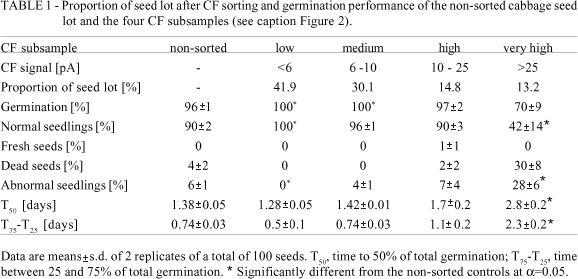Chlorophyll fluorescence of the testa of seeds is proposed as a non-invasive method for the determination of maturity and quality of seeds. In this study cabbage seeds (Brassica oleracea) were sorted individually based on the chlorophyll fluorescence signals into four subsamples labeled with respect to their chlorophyll fluorescence signal (low, medium, high and very high). The results show that the magnitude of the chlorophyll fluorescence signal was inversely related to the quality of the seeds, expressed as germination %, normal seedling %, germination rate (T50) and uniformity of germination (T75-T25). The seed lot could be improved from 90 to 97% normal seedlings by sorting out 13% of the seeds with very high chlorophyll fluorescence signals. Advantages of the chlorophyll fluorescence method for sorting seeds are the high sensitivity, the method being fully non-destructive, the high speed at which the fluorescence is generated and measured and the specificity for only chlorophyll. Other pigments or substances which can influence seed colour but do not fluoresce at the specific wavelengths of excitation and emission of chlorophyll, will not contribute to the fluorescence signal. These characteristics make chlorophyll fluorescence highly suitable as a new sorting technique.
maturation; chlorophyll fluorescence; cabbage seed; sorting; quality



